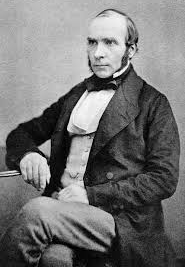Basic Principles
7 John Snow and the Natural Experiment
Historical Background
In a traditional experiment, the researcher maintains control over the organizational considerations of the methodology, but, to ensure that the experiment is unbiased, the researcher may randomly select participants from a designated larger population, and randomly allocate the selected participants to the various control and experimental groups.
The process is shown in Figure 7.1 below.
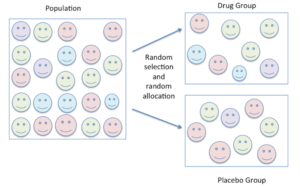
Figure 7.1 Random Selection and Random Allocation in the Typical Experiment
In the natural experiment, the researcher is merely the observer. While they may have decision making control with respect to identifying which areas of a population will be investigated, all of the efforts in enumerating the outcomes of the naturally selected and distributed participants, as well as the exposure to the suspected stimulus will occur aposteriori – after the fact.
The birth of epidemiology and public health is often attributed to the Natural Experiment described by Dr. John Snow in the mid-1800s when he investigated the relationship between drinking contaminated water and the incidence of cholera.
A natural experiment is defined as one in which the researcher has no manipulation of the stimulus or outcome but rather identifies the cohort of interest and the comparison control group, and then waits to observe outcomes in the identified groups. In the measurement of the cholera outbreak of 1854 in London, England, Snow identified individuals that were patrons of two separate water companies (exposed versus not exposed to the stimulus: vibrio cholerae), and simply counted and compared the number of cases of cholera in each group of patrons. In other words, he let the events occur naturally and without his direct influence on the stimulus or outcome.
Figure 7.2 Dr. John Snow
About John Snow
John Snow (1813-1858) was a physician who lived and worked in London, England. In addition to his reputation as an anesthetist for Queen Victoria, he is also known as a pioneer in modern epidemiology. John Snow used the design of a natural experiment to demonstrate the causal association between the waterborne bacterium: Vibrio-Cholerae and the acute intestinal infection that led to widespread death in London during the early 1850s. During the 1830s there were various epidemics, which spread across Europe and although described as cholera, were attributed to social unrest and political upheaval. A later widespread epidemic in 1848 led John Snow to publish a public health pamphlet that described the spread of cholera as being a waterborne infection.
In 1854 there were several misconceptions and misguided beliefs about cholera, especially in regard to the causes of a cholera outbreak. Most commonly, the miasma theory (also called the miasmatic theory) was a commonly accepted explanation for diseases and outbreaks like cholera or the bubonic plague and even sexually transmitted diseases like chlamydia. It was suggested that these illnesses were caused by a noxious form of “bad air”, also known as the night air.
John Snow theorized that the cause of the most recent cholera epidemic (1853-1854) was due to the presence of human waste which included the Vibrio Cholerae bacterium in the water source from selected water supplying companies – most notably the Southwark and Vauxhall Company.
Snow’s theory was based on the location of the water company’s intake spout in relation to the effluent discharge in the Thames River. Snow used a natural experiment design to show that households which received their water from the Southwark and Vauxhall Company, which had an intake spout downstream from the effluent discharge were more likely to present with cholera and cholera-like symptoms than persons in households in a comparative neighborhood that received their drinking water from the Lambeth Water Company, which had placed their intake spout upstream in the Thames River and away from the effluent discharge.
The image on the left, below illustrates the comparison of the positions of the water intake valves for the two companies. The image on the right, below illustrates the distribution of water to the different households by the company supplying the water. Here Snow compared the water from the Southwark and Vauxhall Company to that of the Lambeth Company.
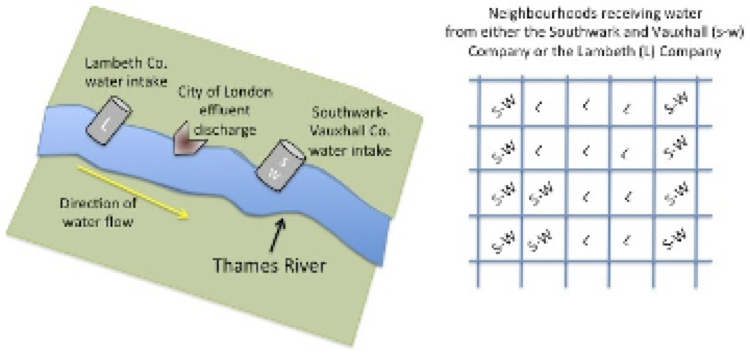
Figure 7.3 Drinking-Water Distribution by the Lambeth Water Company and by the Southwark and Vauxhall Company
The image below is that of the area mapped by John Snow in 1854 to show the location of deaths among households that received their water from the Broad Street Pump. This map presents the area used for patient selection in the natural experiment.
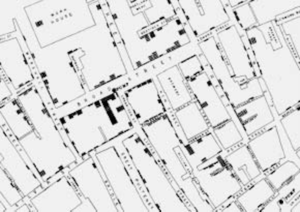
Figure 7.4 Map of deaths among households for the area serviced by the Broad Street Pump
Snow visited households in the district to confirm the number of deaths per household within the given area. The following table shows the number of deaths to households by water source. The data indicate that there were 330 deaths in 334 households that could be attributed to a water source.
| Source of water | Number of Deaths |
| Southwark and Vauxhall company | 286 |
| Lambeth company | 14 |
| Direct from the river | 22 |
| Pump wells | 4 |
| Ditches | 4 |
| Unknown | 4 |
Table 7.1 Distribution of the Number of Deaths Per Household
A SAS graph to evaluate tabled data – reporting on the London Cholera Epidemic
Imagine if John Snow had access to SAS in the 1800s. How might he have presented his findings with respect to comparing cases between Lambeth water consumers versus households that consumed water from Southwark and Vauxhall? Below is a SAS vertical bar chart that presents the data from Table 7.1 above. The program to generate this graph is annotated later in Chapter 12.
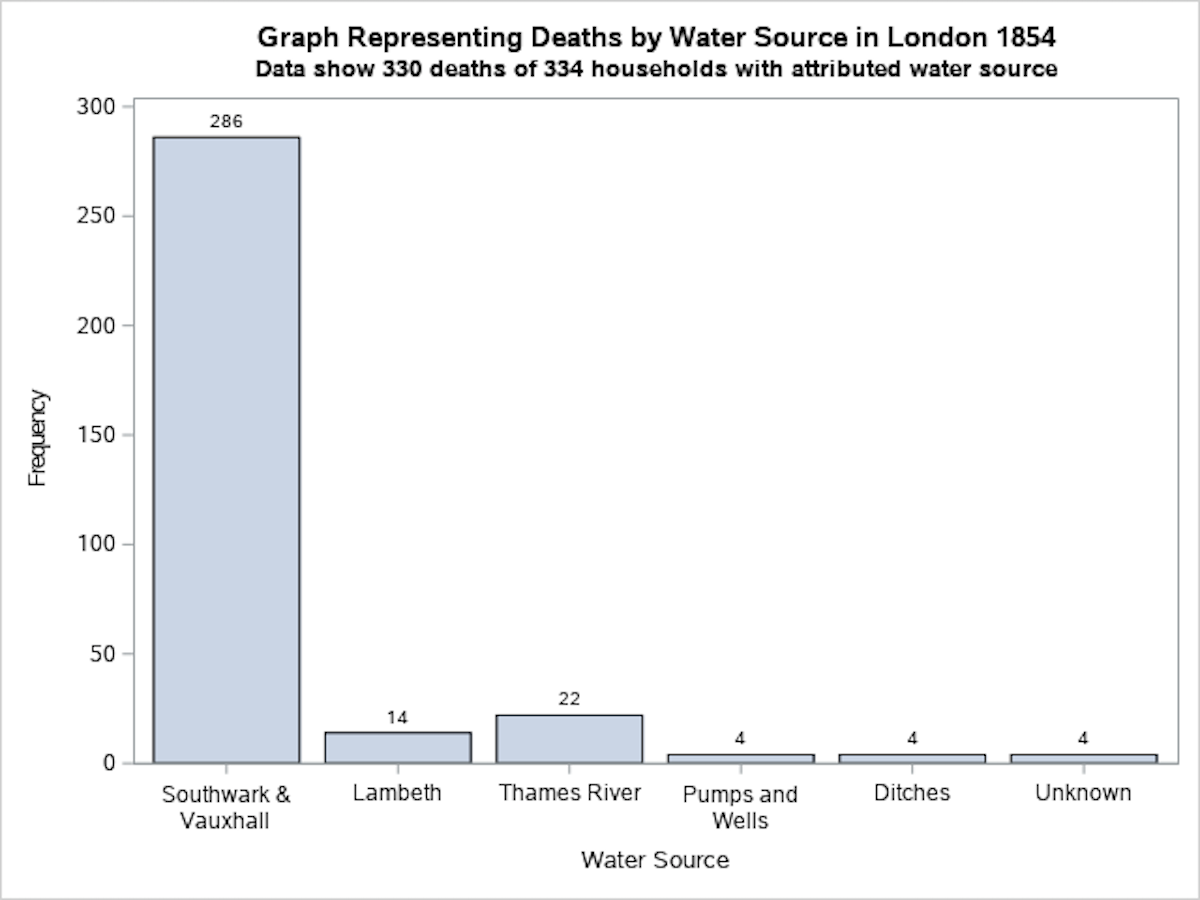
In a follow-up to his original survey of deaths, the following table presents the data for the individuals who died of cholera from 8th July to 26th August 1854. These data indicate the source of water in the households and thereby provide the denominator of all those individuals at risk of death from cholera.
| Source of Water | Total Number of Houses Supplied | Cholera Deaths (n) | Proportion per 10000 persons |
| Southwark -Vauxhall | 40,046 | 1263 | 315.00/104 |
| Lambeth | 26,107 | 98 | 37.53/104 |
| Other | 256,423 | 1422 | 55.46/104 |
Table 7.2 Summary Of Cholera Related Deaths In The Two Neighbourhoods
The computation of deaths attributed to water sources showed that patrons of the Southwark and Vauxhall Company were more than eight times more likely to die from cholera than patrons of the Lambeth Company (315SV / 37.53L= 8.39).
Many years later, in 2017, the World Health Organization described cholera as an acute intestinal infection that is caused by the Vibrio Cholerae bacterium and that causes individuals to experience severe diarrhea leading to dehydration and eventually death. One of the ways the infection is treated is by rehydration through copious consumption of clean water. Unfortunately for those villages that continue to overcome this epidemic, the difficulty is in the ability to locate clean water.

